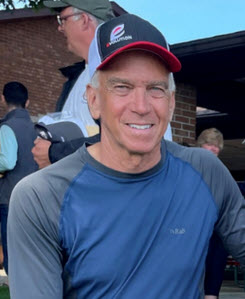What the winners are doing
Published on November 22nd, 2021
While multi-class champion Greg Fisher is well known in one design sailing as an elite sailmaker and sailor, his brother Matt is a serious threat too. Here are some tips Matt shared with Evolution Sails after winning the 2021 Interlake National Championship:
First weather leg:
We have gotten away from trying to guess which side is favored. We spent 3 or 5 years trying to determine which side will be favored. We weren’t very good at that. Sure, in light air, especially in very light air, we will look upwind with 2 minutes to go and try to see if we can tell if there is any more pressure on one side or another.
But our “strategy” in 90% of the races is start near the favored end and sail the shifts. Sure we end up on a side and have sailed lifts out to a side when we are trying to get back to the middle. But we do not try to guess which side is favored.
Yes, one side often times will come in and often the people that win from that side after the race will either say they sailed up the middle or they saw something on that side; but we sail shifts as much as we possibly can.
Rig turning:
I never deviate from the tuning guide. If your brother is a sailmaker, and you ever complain about your boat speed, and he finds out you are not tuned according to the tuning guide he wrote, you are in for a long Thanksgiving dinner.
Up-your-sleeve secrets:
I don’t have tricks, I don’t think. Sail in many different sailing conditions as possible and work on your weaknesses As importantly; before your next fleet race ask the fastest boat in your fleet to sail next to you side by side upwind — and downwind. Look at what they do. Best case, get someone to take pictures of your boat and theirs. You will see differences.
Being fast downwind:
I think it is knowing your angles in the lighter air, and keeping good balance and sailing low in the puffs and waves in the heavier air. When it is under 6 or 7, there are angles you can take that result in your optimum speed or VMG (I really don’t use that acronym, just wanted to try it here). Even in the light air, you want to keep the spinnaker full and keep trying to drive down until your chute flyer tells you that they don’t have good pressure.
But communicating with your crew/teammates is the most important part of downwind sailing. As I just said, constant communication with the spinnaker flyer — in all conditions — is critical. When a puffs makes its way to your boat, the spinnaker flyer should tell the skipper, “I have a good puff’ and the skipper should say, “Okay, I am taking it down. Is that too far?” The spinnaker flyer then says, “Yup too far”, or “Nope, I’m good.”
I am having that conversation with the spinnaker flyer the entire leg. If you are sailing with 3, use the third to call puffs in all conditions. Where the puffs are and when they will hit. This is incredibly valuable. Have that person look for where the spinnakers are flying higher in light air, and encourage them to have the authority to encourage the skipper to steer the boat closer to that puff if it is possible. In a big breeze it is equally important to sail under the puffs.










 We’ll keep your information safe.
We’ll keep your information safe.